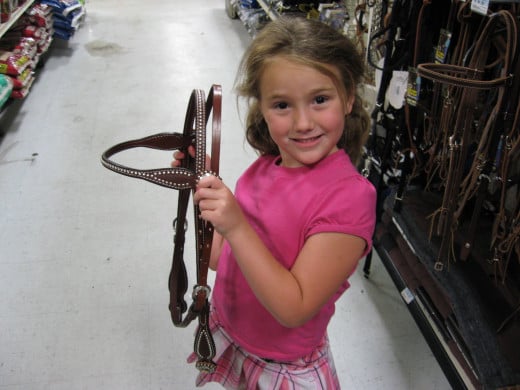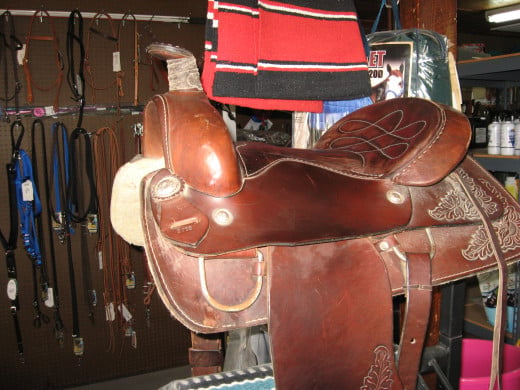How to Prevent Injuries from Falling off a Horse

Horseback Riding
I’ve spent a huge portion of my life riding horses and working with horses. As a result, I’ve learned a thing or two about how to prevent injuries from falling off a horse. And yes, I’ve taken many spills from numerous equines. Does that mean I wasn’t a good rider? No, it doesn’t. I was an excellent rider and could even run barrels bareback. Part of my problem with horseback riding when I was younger was that I was somewhat of a daredevil. I’d often ride horses that others were afraid to ride, and I also spent a good bit of time horse training. When I was training horses, I worked with several young animals that had never been ridden, along with older equines that hadn’t been handled much or that had major behavior problems. Trust me: If you ride enough different horses over the course of several decades in a wide range of situations, you’ll part company with your mount at some point. The question isn’t if you’ll fall off – it’s when you’ll take a fall and how bad it’ll be. Some falls are much worse than others, obviously. That being said, you can learn how to prevent injuries from falling off a horse. These tips aren’t fail-proof, but I think beginners will find them helpful.

Preventing Accidents And Injuries
Preventing accidents and injuries is always better than dealing with their actual occurrence. While you can never prevent 100% of accidents, injuries, and other mishaps, you can certainly decrease their likelihood. You’ll need to be mindful of how you ride, of your horse, of other horses nearby, of your tack, and of your surroundings in order to cut down on the risk of problems.
Much of accident and injury prevention is common sense and planning ahead. Sometimes novices aren’t really aware of everything that might go wrong. That may be because they’re overconfident in their riding skills, because they misjudge their mount, or because they simply don’t know enough about horse behavior or about interpreting horse body language. This isn’t an exact science, and even expert horsemen can get it wrong sometimes or be caught by surprise. Being prepared, however, is a big step in the right direction.
Riding accidents like falling off a horse can be painful, serious, and even fatal. A fall might result in simple scrapes and minor bruising, but it could also result in broken bones, deep lacerations, or head injuries. Even if you never step into the saddle, working with horses can be dangerous. Handlers can get bitten, kicked, stepped on, or pawed. I’ve been bitten by a horse before, and it was extremely painful. I still bear the scar on my forearm. This article, however, focuses on preventing accidents and injuries while horseback riding – not on handling or training horses. If you’re a beginning rider, please take this advice seriously.
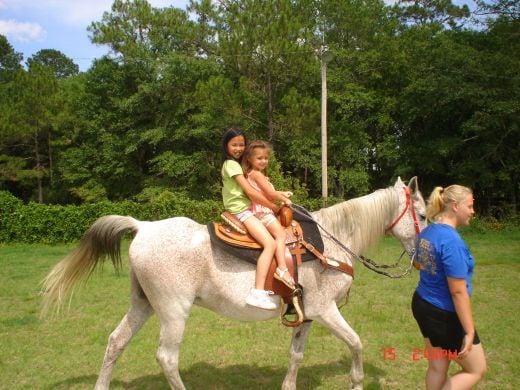
Horse Riding Lessons
Before you attempt horse riding on your own, make sure you know what you’re doing. Horses are big and powerful, and they can be very unpredictable. Even a well trained horse and an experienced rider can sometimes run into problems. Sometimes calm, gentle mounts can shy or spook unexpectedly, as I’ve learned firsthand.
Most shying and spooking are results of a horse’s vision and its mentality. For millions of years, equines were prey animals that served as food for predators. They have a “flight or fight” mindset, and they almost always choose flight when it’s an option. Horses have monocular vision. In other words, a horse has eyes that work separately. Like most prey animals, the eyes are positioned on the sides of the head. The monocular vision gives the animal a wide visual range, but it doesn’t provide much depth perception. We humans have binocular vision, as most predators do. We have depth perception that horses lack. When a horse sees a piece of paper with one eye, it can’t tell how far away the paper is. If and when it sees the paper with the other eye, the paper might appear to the horse to be “jumping out” at it. If you watch the horse body language, you can sometimes divert the animal’s attention before an all-out spook reaction happens.
The best horse riding lessons include lots of hours in the saddle. A note of caution here: Just because you can successfully ride old Molly down at the local stables doesn’t mean you’re prepared to ride any and every horse. Equines are individuals, and they’re not all trained to respond to the exact same cues. Of course, some horses are much more challenging to ride than others, too. This might because they’re younger animals, because they’re more spirited, or because they have behavioral issues.
Once you have your basic riding skills down pat on one horse, I think it’s best to learn to ride another horse. And then another…and another. You’ll learn something new from each mount, and you’ll gain a better understanding of horses, in general. You’ll quickly realize that not all steeds are alike. Horseback riding isn’t like driving a car or operating a machine. These flesh-and-blood modes of transportation have their own minds.

How To Ride A Horse
Learning the basics of how to ride a horse is paramount. Hopefully, you’ve already had some horse riding lessons – whether they were formal or informal. Riding lessons are great, but a few sessions does not an expert make. You won’t become Roy Rogers from riding a dependable old plug one day a week. Learning how to ride a horse at a walk in a controlled environment isn’t the same as being a great rider. It’s a start, of course, and it’s a good way to gain some experience and to increase your confidence.
The key to horseback riding is control. You have to learn to control the animal and to control your own body. For beginners who haven’t yet learned to use leg cues, the bridle is the vehicle for control of the mount, and the way you hold the reins is important. I often see novices holding the reins a foot or more from the animal’s neck, or way up in the air, which supplies little control. You need to keep your rein-holding hand low and just a few inches from the horse’s neck, even with the horn.
As far as your body is concerned, it’s all about balance. Sit up straight, with your heels slightly lower than your toes. Use the ESHH method – ears, shoulders, hips, heels. If an observer were to look at your sitting in the saddle from a side view, he should notice that your ear, shoulder, hip, and heel are all in alignment.
Stirrup length is important, too. They shouldn’t be too high or too low. Your legs should be bent slightly at the knee, and you should be able to stand in the stirrups. Many horsemen say you should be able to fit your fist between your seat and the saddle when standing up in the stirrups, but this doesn’t work for everyone. With practice, you’ll get the right “feel” for sticking to the saddle. By the way, your heels don’t need to be touching the horse’s sides unless you’re cuing the animal to move out.
It’s also important to remember that your balance affects the mount’s balance. Leaning too far back or too far forward in the saddle could throw off the animal’s balance and put extra strain on parts of the horse where it doesn’t need to be. When you first start riding horses, you might feel like you’re going to fall off. With enough practice, though, sitting a horse will become second nature to you. The following video will show you how to sit a western saddle.
How To Ride A Horse:
Horse Tack
Using the right horse tack can help with injury prevention. I occasionally rode with an English saddle, but most of my horse riding was done in a western saddle – or bareback, with no saddle at all. In my humble opinion, western saddles are best for beginners because they provide more security for the rider. You’ll have something in front of and behind your seat to help hold you in place, and you’ll have a horn to grab should you need it.
Before mounting a horse, make sure all the horse tack is in proper working order. Check the bridle and make sure it’s in good repair. Do the same with the stirrup leathers and the girth strap. If the bridle or reins break during a ride, you’ll have no control over your mount, which can be a very scary experience. If a stirrup leather breaks, you might lose your balance and wind up falling off. If the belly girth breaks, the saddle will slide off, and you’ll go with it.
You’ll also need to make sure the tack fits the animal properly. The bit should just crease the corners of the horse’s mouth. If the bridle is too loose, the bit will fall too low, and you won’t be able to control the steed adequately. If the bridle is too tight, it will be uncomfortable to the horse and could cause the animal to misbehave. The belly girth needs to be snug, too. When you’re tightening the cinch strap, the horse will probably “blow up.” In other words, it might take a deep breath to expand its chest. The girth might fit tightly when you first mount the horse, but after the animal releases, the girth could become too loose for safety.
You’ll need to examine your blanket or saddle pad before placing it on the animal’s back, too. Debris often sticks to the fabric or “fuzz” of a saddle pad with a Velcro-like action. Obviously, these will prove to be very annoying to your horse when they rub against its back under your weight. You’ll need to remove any foreign particles before placing the pad or blanket. Shake out the pad first, and then go over it with your hand to feel for more debris. If you find something like a burr that’s hard to remove, cut it out carefully with a pair of scissors.
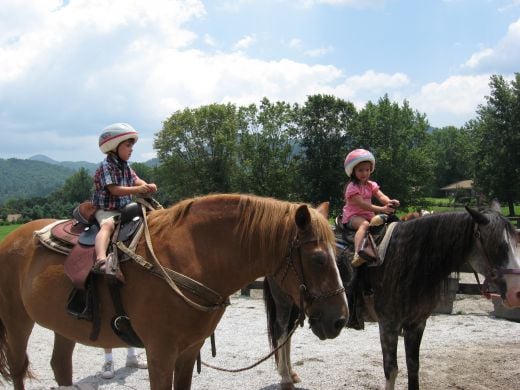
Safety Equipment
We’ve discussed horse tack. Now a word about safety equipment: In my opinion, the two most important items for injury prevention while horse riding are riding helmets and riding boots. A helmet will protect your head, and a good pair of boots will help you stay safely in the saddle. You might also want to consider wearing a safety vest to protect your rib cage, along with riding gloves to protect your hands.
One of the best pieces of safety equipment is in human form - a riding buddy. I think it’s especially important for novices to avoid riding alone. If you’re all alone in an accident, you might not be able to get help. You might not be able to move, or you could even lose consciousness. You’d have to lie there until someone happened to come along. Even when you’re riding with others, it’s a good idea for at least one of you to have a cell phone handy. In case of an emergency, someone could quickly call for backup.
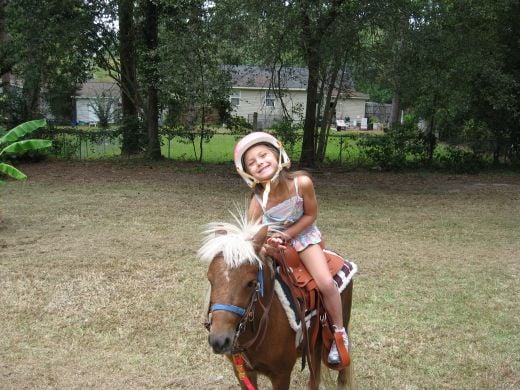
Horse Riding Helmets – Head Injuries
I think horse riding helmets are extremely important, especially for children and adult beginners. Head injuries are nothing to play around with. And yes, I speak from personal experience. One of my riding pals, one of my daughters, and I have all suffered head injuries while horseback riding. By the way, none of us were wearing horse riding helmets when the injuries occurred. Back then, no one I knew wore helmets. Now, however, I’m older and wiser. I usually make my grandchildren wear a helmet when they’re riding horses.
The head injuries I have personal knowledge of include stitches, concussions, and temporary amnesia. Three required hospitalization. When I was just a toddler, a fall from a horse resulted in my receiving ten stitches in my forehead. When I was a teen, one of my friends and I were racing our mounts one afternoon, and she fell off when her mount was scared by an ATV. She received a concussion and had amnesia for several days. I got a concussion from a fall as a teenager, too, and so did my middle daughter. I didn’t have amnesia, but my daughter did. Let me tell you – that was a frightening experience. All these injuries would probably have been prevented had we been wearing helmets.
Horse Riding Helmets:
Head Injuries:
Riding Helmets:
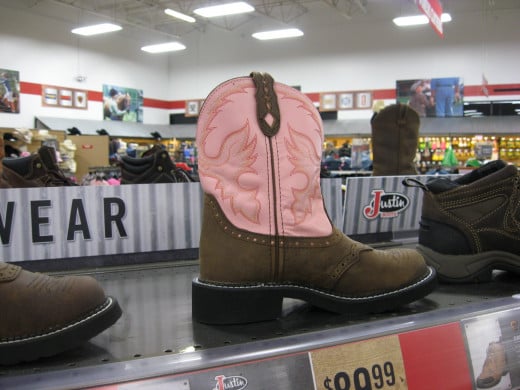
Riding Boots
While my friends and I didn’t wear riding helmets, we did wear riding boots. A proper pair of boots can be important safety equipment. We usually wore cowboy boots, which were specifically designed with horse riding in mind. The pointed toe will help you get your foot into the stirrup, and the stout heel will help hold your foot in the right position in the stirrup. The leather shaft will help prevent chafing from the leathers, too.
Of course, there are lots of different styles and types of riding boots. Just be sure to get a pair that fits you well, and make sure the boots have a good heel. The heel provides a “stop” that will help prevent your foot from going all the way through the stirrup. This is important for injury prevention. Should your foot slide through the stirrup during a fall, you could be dragged by the horse, leading to serious injury or even death.

Horse Body Language
Learning to read horse body language is important, too. Interpreting it correctly can often clue you to horse behavior, and when you can understand horse behavior, you can often anticipate an impending problem and take action before an accident occurs. I’ll give you a few examples of horse body language to show you what I’m talking about.
When an equine flattens it ears against its head, the animal isn’t happy. It could mean that it’s ready to “act up.” When some horses are agitated, they wring their tails – another sure sign the steed is upset. In some horses, pawing means impatience. Pawing might also indicate that the horse is preparing to lie down – maybe with you in the saddle. I’ve ridden scores of horses that would paw whenever we entered water. I learned quickly that some of these mounts were intending to lie down in the water. After that happened a couple of times, I knew to take action once the pawing began. I either rode the horse out of the water or cued it to move forward.
Because of an equine’s vision, they can become easily spooked by rather mundane objects. This could include a piece of paper, an empty soft drink can, or other things you might encounter while horseback riding. When a horse sees something that it’s afraid of, it can bolt, shy, or run away. If you’re an observant rider, you can often nip this in the bud by reading horse body language. In this case, the animal will often drop its head to get a better look at the offending object, or it might side-step the item.
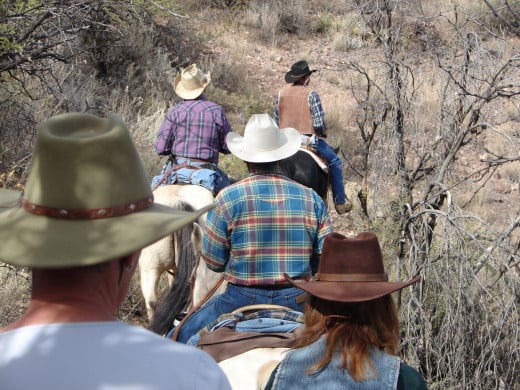
How To Prevent Injuries From Falling Off A Horse
Falling off a horse usually isn’t much fun, but some falls are a lot less “fun” than others. Believe it or not, you can sometimes make falling off a horse easier on yourself if you take action during the fall. Coming unseated might sound like a no-brainer, right? How does one lessen the severity of a fall? Admittedly, sometimes you can’t. Sometimes it happens so fast that you don’t have time to think. At other times, however, you might have the presence of mind to make some split-second decisions.
The first tip I’m sharing with you is more about prevention, and I learned it from a friend of mine, after watching her fall off one day. it was during the winter, and she was wearing a heavy button-up coat. Her horse shied, and my pal fell forward onto the saddle horn. The horn became wedged between two buttons, so my buddy was virtually impaled on the horn, with no way to escape. I finally caught her mount and helped her regain her stirrups.
Try to make sure you kick free of the stirrups during a fall. I’ve already mentioned the possibility of being dragged, and you definitely want to avoid this, if possible. Wearing the right riding boots will help prevent this, as will holding your feet in the right position. If you’re able to do so, you’ll also need to push yourself away from the horse, and try to tuck your head, roll up into a ball, and roll away from the animal. This will help prevent head injuries and being trampled by the sharp hooves.
If you’re riding a green horse or one you’re not sure of, I suggest riding in a deeply plowed area. When I was involved with horse training, I chose such places to ride and exercise the equines. Landing on soft, “fluffy” soil is a heck of a lot better than landing on hard packed dirt or pavement. Working with horses in deep soil also provides a good workout for the animal, and the soft surface is much more forgiving with the horse’s joints and bones, too.
After you’ve fallen, make sure you’re safe from your horse and from other horses. If you are, don’t move right away. Do your best to ascertain where your pain is focused and how severe it is. If you have severe back pain, it’s best not to try to move – you could make a back injury worse by doing so. Otherwise, make sure all your other “parts” are working. Can you wiggle your fingers and toes? Can you bend your wrists, ankles, elbows, and knees? Hopefully, you’ve taken my advice and have not gone out riding alone. If you’re seriously injured, stay put until help arrives. Have someone catch your horse for you, too, and make sure it’s safe, uninjured, and under control.
